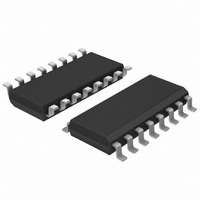74LVC138AD,112 NXP Semiconductors, 74LVC138AD,112 Datasheet - Page 16

74LVC138AD,112
Manufacturer Part Number
74LVC138AD,112
Description
IC DECODER/DEMUX 3-8 INV 16SOIC
Manufacturer
NXP Semiconductors
Series
74LVCr
Type
Decoder/Demultiplexerr
Datasheet
1.74LVC138AD118.pdf
(20 pages)
Specifications of 74LVC138AD,112
Package / Case
16-SOIC (3.9mm Width)
Circuit
1 x 3:8
Independent Circuits
1
Current - Output High, Low
24mA, 24mA
Voltage Supply Source
Single Supply
Voltage - Supply
2.7 V ~ 3.6 V
Operating Temperature
-40°C ~ 125°C
Mounting Type
Surface Mount
Logic Family
74LVC
Number Of Lines (input / Output)
6.0 / 8.0
Propagation Delay Time
2.8 ns
Supply Voltage (max)
3.6 V
Supply Voltage (min)
1.2 V
Maximum Operating Temperature
+ 125 C
Minimum Operating Temperature
- 40 C
Mounting Style
SMD/SMT
Number Of Input Lines
6.0
Number Of Output Lines
8.0
Power Dissipation
500 mW
Lead Free Status / RoHS Status
Lead free / RoHS Compliant
Lead Free Status / RoHS Status
Lead free / RoHS Compliant, Lead free / RoHS Compliant
Other names
568-1577-5
74LVC138AD
935260745112
74LVC138AD
935260745112
Philips Semiconductors
SOLDERING
Introduction to soldering surface mount packages
This text gives a very brief insight to a complex technology.
A more in-depth account of soldering ICs can be found in
our “Data Handbook IC26; Integrated Circuit Packages”
(document order number 9398 652 90011).
There is no soldering method that is ideal for all surface
mount IC packages. Wave soldering can still be used for
certain surface mount ICs, but it is not suitable for fine pitch
SMDs. In these situations reflow soldering is
recommended.
Reflow soldering
Reflow soldering requires solder paste (a suspension of
fine solder particles, flux and binding agent) to be applied
to the printed-circuit board by screen printing, stencilling or
pressure-syringe dispensing before package placement.
Several methods exist for reflowing; for example,
convection or convection/infrared heating in a conveyor
type oven. Throughput times (preheating, soldering and
cooling) vary between 100 and 200 seconds depending
on heating method.
Typical reflow peak temperatures range from
215 to 250 C. The top-surface temperature of the
packages should preferably be kept:
Wave soldering
Conventional single wave soldering is not recommended
for surface mount devices (SMDs) or printed-circuit boards
with a high component density, as solder bridging and
non-wetting can present major problems.
To overcome these problems the double-wave soldering
method was specifically developed.
2003 May 06
below 220 C for all the BGA packages and packages
with a thickness
thickness <2.5 mm and a volume 350 mm
thick/large packages
below 235 C for packages with a thickness <2.5 mm
and a volume <350 mm
3-to-8 line decoder/demultiplexer; inverting
2.5mm and packages with a
3
so called small/thin packages.
3
so called
16
If wave soldering is used the following conditions must be
observed for optimal results:
During placement and before soldering, the package must
be fixed with a droplet of adhesive. The adhesive can be
applied by screen printing, pin transfer or syringe
dispensing. The package can be soldered after the
adhesive is cured.
Typical dwell time is 4 seconds at 250 C.
A mildly-activated flux will eliminate the need for removal
of corrosive residues in most applications.
Manual soldering
Fix the component by first soldering two
diagonally-opposite end leads. Use a low voltage (24 V or
less) soldering iron applied to the flat part of the lead.
Contact time must be limited to 10 seconds at up to
300 C.
When using a dedicated tool, all other leads can be
soldered in one operation within 2 to 5 seconds between
270 and 320 C.
Use a double-wave soldering method comprising a
turbulent wave with high upward pressure followed by a
smooth laminar wave.
For packages with leads on two sides and a pitch (e):
– larger than or equal to 1.27 mm, the footprint
– smaller than 1.27 mm, the footprint longitudinal axis
The footprint must incorporate solder thieves at the
downstream end.
For packages with leads on four sides, the footprint must
be placed at a 45 angle to the transport direction of the
printed-circuit board. The footprint must incorporate
solder thieves downstream and at the side corners.
longitudinal axis is preferred to be parallel to the
transport direction of the printed-circuit board;
must be parallel to the transport direction of the
printed-circuit board.
Product specification
74LVC138A















